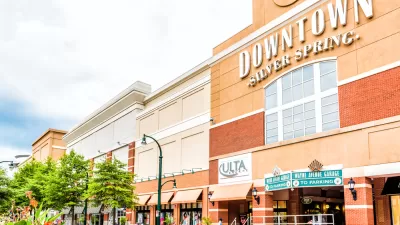A hotly contested development in the coastal enclave of Santa Monica, CA—soon to be blessed with light rail access to the rest of the region—has produced less-than-ambitious results.

"The Bergamot Transit Village saga is likely to end this week with a whimper as plans to turn the seven-acre site, once slated to become a mixed-use neighborhood across from the Expo Line 26th Street station, into a suburban-style office park continue to move forward," reports Jason Islas.
The Expo Line is the under-construction light rail line that will connect Downtown Los Angeles with Santa Monica—expected to open in 2016 and attract large ridership numbers.
The article provides more details about the development proposal considered by the city's Architecture Review Board last week. The ARB is only considering design elements, because the development is allowed by-right. The project adds 7,400 square feet of office space to bring the total on the site to 204,000 square feet.
The previous plan, known as the Bergamont Transit Village, sparked threats of a referendum. That was enough to inspire the city council to rescind its initial approval of the project. The Bergamont Project Village "would have created more than 400 apartments — including about 50 subsidized affordable units — and about 400,000 square feet of new offices directly across the street from the future Expo light rail station at 26th Street and Olympic Boulevard. The new community would have also had the city’s most aggressive traffic demand management (TDM) program," according to Islas.
FULL STORY: SUBURBAN-STYLE OFFICE PARK AT FORMER BERGAMOT TRANSIT VILLAGE SITE MOVES FORWARD

Maui's Vacation Rental Debate Turns Ugly
Verbal attacks, misinformation campaigns and fistfights plague a high-stakes debate to convert thousands of vacation rentals into long-term housing.

Planetizen Federal Action Tracker
A weekly monitor of how Trump’s orders and actions are impacting planners and planning in America.

In Urban Planning, AI Prompting Could be the New Design Thinking
Creativity has long been key to great urban design. What if we see AI as our new creative partner?

King County Supportive Housing Program Offers Hope for Unhoused Residents
The county is taking a ‘Housing First’ approach that prioritizes getting people into housing, then offering wraparound supportive services.

Researchers Use AI to Get Clearer Picture of US Housing
Analysts are using artificial intelligence to supercharge their research by allowing them to comb through data faster. Though these AI tools can be error prone, they save time and housing researchers are optimistic about the future.

Making Shared Micromobility More Inclusive
Cities and shared mobility system operators can do more to include people with disabilities in planning and operations, per a new report.
Urban Design for Planners 1: Software Tools
This six-course series explores essential urban design concepts using open source software and equips planners with the tools they need to participate fully in the urban design process.
Planning for Universal Design
Learn the tools for implementing Universal Design in planning regulations.
planning NEXT
Appalachian Highlands Housing Partners
Mpact (founded as Rail~Volution)
City of Camden Redevelopment Agency
City of Astoria
City of Portland
City of Laramie





























